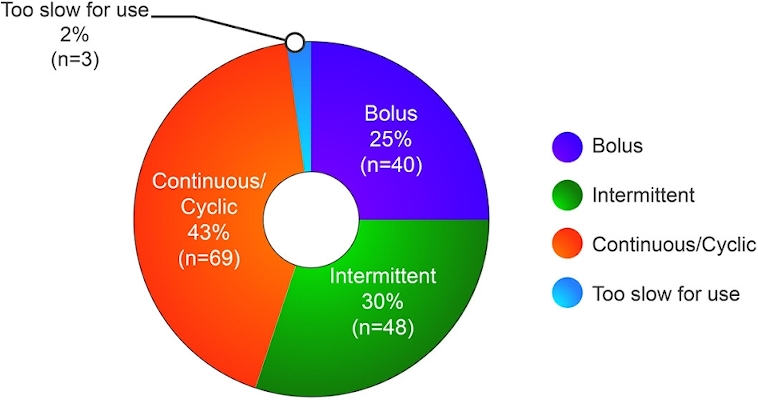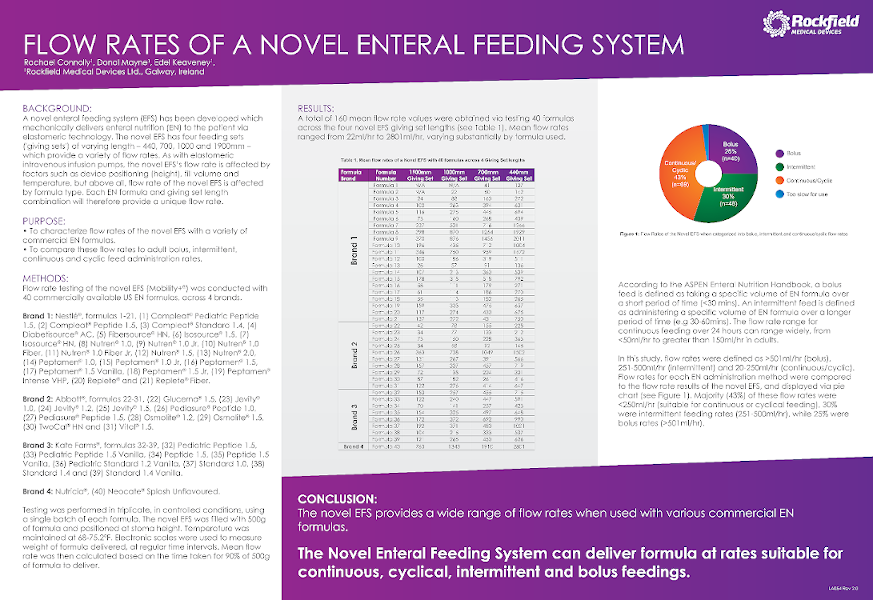Abstract
Poster presented at ASPEN conference.
Rockfield has been featured in the ASPEN Journal of Parenteral and Enteral Nutrition. It publishes original peer-reviewed studies that define the cutting edge of basic and clinical research in the field.
Authors
Rachael Connolly, Bsc Human Nutrition; Donal Mayne, Msc Medical Device Design; Edel Keaveney, Bsc, PhD Nutrition
You can view the original article here:
https://aspenjournals.onlinelibrary.wiley.com/doi/full/10.1002/jpen.2604Background
A novel enteral feeding system (EFS) has been developed which mechanically delivers enteral nutrition (EN) to the patient via elastomeric technology. The novel EFS has four feeding sets ('giving sets') of varying length –440, 700, 1000 and 1900mm–which provide a variety of flow rates. As with elastomeric intravenous infusion pumps, the novel EFS's flow rate is affected by factors such as device positioning (height), fill volume and temperature, but above all, flow rate of the novel EFS is affected by formula type. Each EN formula and giving set length combination will therefore provide a unique flow rate.
Purpose
To characterize flow rates of the novel EFS with a variety of commercial EN formulas, and compare these flow rates to adult bolus, intermittent, continuous, and cyclic feed administration rates.
Methods
Flow rate testing of the novel EFS (Mobility+®) was conducted with 40 commercially available US EN formulas, across 4 brands.
Brand 1: Nestlé®, formulas 1-21, (1) Compleat® Pediatric Peptide 1.5, (2) Compleat® Peptide 1.5, (3) Compleat® Standard 1.4, (4) Diabetisource® AC, (5) Fibersource® HN, (6) Isosource® 1.5, (7) Isosource® HN, (8) Nutren® 1.0, (9) Nutren® 1.0 Jr, (10) Nutren® 1.0 Fiber, (11) Nutren® 1.0 Fiber Jr, (12) Nutren® 1.5, (13) Nutren® 2.0, (14) Peptamen® 1.0, (15) Peptamen® 1.0 Jr, (16) Peptamen® 1.5, (17) Peptamen® 1.5 Vanilla, (18) Peptamen® 1.5 Jr, (19) Peptamen® Intense VHP, (20) Replete® and (21) Replete® Fiber.
Brand 2: Abbott®, formulas 22-31, (22) Glucerna® 1.5, (23) Jevity® 1.0, (24) Jevity® 1.2, (25) Jevity® 1.5, (26) Pediasure® Peptide 1.0, (27) Pediasure® Peptide 1.5, (28) Osmolite® 1.2, (29) Osmolite® 1.5, (30) TwoCal® HN and (31) Vital® 1.5.
Brand 3: Kate Farms®, formulas 32-39, (32) Pediatric Peptide 1.5, (33) Pediatric Peptide 1.5 Vanilla, (34) Peptide 1.5, (35) Peptide 1.5 Vanilla, (36) Pediatric Standard 1.2 Vanilla, (37) Standard 1.0, (38) Standard 1.4 and (39) Standard 1.4 Vanilla.
Brand 4: Nutricia®, (40) Neocate® Splash Unflavoured.
Testing was performed in triplicate, in controlled conditions, using a single batch of each formula. The novel EFS was filled with 500g of formula and positioned at stoma height. Temperature was maintained at 68 °F to 75.2 ºF. Electronic scales were used to measure weight of formula delivered, at regular time intervals. Mean flow rate was then calculated based on the time taken for 90% of 500 g of formula to deliver.
Results
A total of 160 mean flow rate values were obtained via testing 40 formulas across the four novel EFS giving set lengths (see Table 1). Mean flow rates ranged from 22ml/hour to 2801ml/hour, varying substantially by formula used. According to the ASPEN Enteral Nutrition Handbook, a bolus feed is defined as taking a specific volume of EN formula over a short period of time (<30 mins). An intermittent feed is defined as administering a specific volume of EN formula over a longer period (eg, 30-60 min). The flow rate range for continuous feeding over 24 hours can range widely, from <50ml/hour to greater than 150ml/hour in adults. In this study, flow rates were defined as >501ml/hr (bolus), 251-500ml/hr (intermittent) and 20-250ml/hour (continuous/cyclic). Flow rates for each EN administration method were compared to the flow rate results of the novel EFS and displayed via pie chart (see Figure 1). The majority (43%) of these flow rates were <250ml/hour (suitable for continuous or cyclical feeding), 30% were intermittent feeding rates (251-500 ml/h), while 25% were bolus rates (>501 ml/h).
Conclusion
The novel EFS provides a wide range of flow rates when used with various commercial EN formulas. The novel EFS can deliver EN formula at rates suitable for continuous, cyclical, intermittent and bolus feedings.
Table 1
Mean Flow Rates of a Novel EFS With 40 Formulas Across Four Giving Set Lengths.

Figure 1
Flow rates of the Novel EFS when categorized into bolus, intermittent, and continuous/cycle flow rates.

Poster
Click to view the PDF version here.
